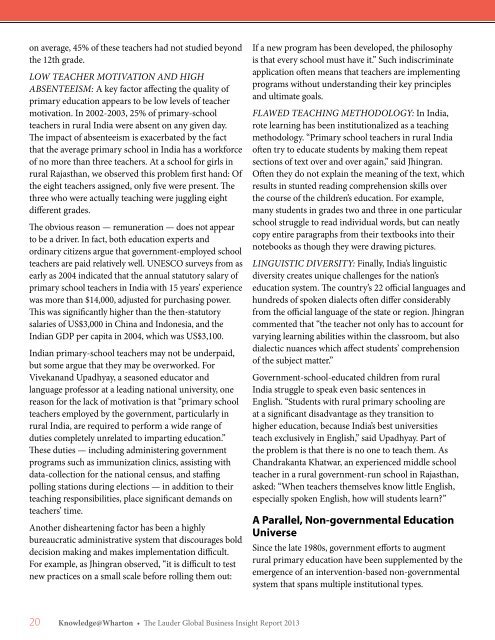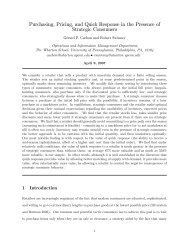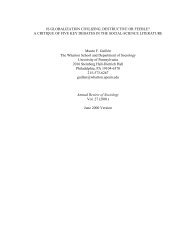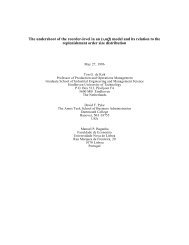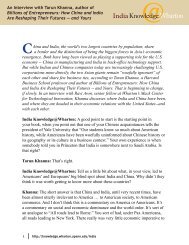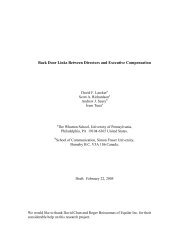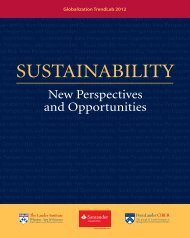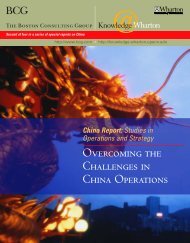building blocks for the Global economy - Knowledge@Wharton
building blocks for the Global economy - Knowledge@Wharton
building blocks for the Global economy - Knowledge@Wharton
You also want an ePaper? Increase the reach of your titles
YUMPU automatically turns print PDFs into web optimized ePapers that Google loves.
on average, 45% of <strong>the</strong>se teachers had not studied beyond<br />
<strong>the</strong> 12th grade.<br />
LOW TEACHER MOTIvATION AND HIGH<br />
ABsENTEEIsM: A key factor affecting <strong>the</strong> quality of<br />
primary education appears to be low levels of teacher<br />
motivation. In 2002-2003, 25% of primary-school<br />
teachers in rural India were absent on any given day.<br />
The impact of absenteeism is exacerbated by <strong>the</strong> fact<br />
that <strong>the</strong> average primary school in India has a work<strong>for</strong>ce<br />
of no more than three teachers. At a school <strong>for</strong> girls in<br />
rural Rajasthan, we observed this problem first hand: Of<br />
<strong>the</strong> eight teachers assigned, only five were present. The<br />
three who were actually teaching were juggling eight<br />
different grades.<br />
The obvious reason — remuneration — does not appear<br />
to be a driver. In fact, both education experts and<br />
ordinary citizens argue that government-employed school<br />
teachers are paid relatively well. UNESCO surveys from as<br />
early as 2004 indicated that <strong>the</strong> annual statutory salary of<br />
primary school teachers in India with 15 years’ experience<br />
was more than $14,000, adjusted <strong>for</strong> purchasing power.<br />
This was significantly higher than <strong>the</strong> <strong>the</strong>n-statutory<br />
salaries of US$3,000 in China and Indonesia, and <strong>the</strong><br />
Indian GDP per capita in 2004, which was US$3,100.<br />
Indian primary-school teachers may not be underpaid,<br />
but some argue that <strong>the</strong>y may be overworked. For<br />
Vivekanand Upadhyay, a seasoned educator and<br />
language professor at a leading national university, one<br />
reason <strong>for</strong> <strong>the</strong> lack of motivation is that “primary school<br />
teachers employed by <strong>the</strong> government, particularly in<br />
rural India, are required to per<strong>for</strong>m a wide range of<br />
duties completely unrelated to imparting education.”<br />
These duties — including administering government<br />
programs such as immunization clinics, assisting with<br />
data-collection <strong>for</strong> <strong>the</strong> national census, and staffing<br />
polling stations during elections — in addition to <strong>the</strong>ir<br />
teaching responsibilities, place significant demands on<br />
teachers’ time.<br />
Ano<strong>the</strong>r disheartening factor has been a highly<br />
bureaucratic administrative system that discourages bold<br />
decision making and makes implementation difficult.<br />
For example, as Jhingran observed, “it is difficult to test<br />
new practices on a small scale be<strong>for</strong>e rolling <strong>the</strong>m out:<br />
20 <strong>Knowledge@Wharton</strong> • The Lauder <strong>Global</strong> Business Insight Report 2013<br />
If a new program has been developed, <strong>the</strong> philosophy<br />
is that every school must have it.” Such indiscriminate<br />
application often means that teachers are implementing<br />
programs without understanding <strong>the</strong>ir key principles<br />
and ultimate goals.<br />
FLAWED TEACHING METHODOLOGY: In India,<br />
rote learning has been institutionalized as a teaching<br />
methodology. “Primary school teachers in rural India<br />
often try to educate students by making <strong>the</strong>m repeat<br />
sections of text over and over again,” said Jhingran.<br />
Often <strong>the</strong>y do not explain <strong>the</strong> meaning of <strong>the</strong> text, which<br />
results in stunted reading comprehension skills over<br />
<strong>the</strong> course of <strong>the</strong> children’s education. For example,<br />
many students in grades two and three in one particular<br />
school struggle to read individual words, but can neatly<br />
copy entire paragraphs from <strong>the</strong>ir textbooks into <strong>the</strong>ir<br />
notebooks as though <strong>the</strong>y were drawing pictures.<br />
LINGuIsTIC DIvERsITY: Finally, India’s linguistic<br />
diversity creates unique challenges <strong>for</strong> <strong>the</strong> nation’s<br />
education system. The country’s 22 official languages and<br />
hundreds of spoken dialects often differ considerably<br />
from <strong>the</strong> official language of <strong>the</strong> state or region. Jhingran<br />
commented that “<strong>the</strong> teacher not only has to account <strong>for</strong><br />
varying learning abilities within <strong>the</strong> classroom, but also<br />
dialectic nuances which affect students’ comprehension<br />
of <strong>the</strong> subject matter.”<br />
Government-school-educated children from rural<br />
India struggle to speak even basic sentences in<br />
English. “Students with rural primary schooling are<br />
at a significant disadvantage as <strong>the</strong>y transition to<br />
higher education, because India’s best universities<br />
teach exclusively in English,” said Upadhyay. Part of<br />
<strong>the</strong> problem is that <strong>the</strong>re is no one to teach <strong>the</strong>m. As<br />
Chandrakanta Khatwar, an experienced middle school<br />
teacher in a rural government-run school in Rajasthan,<br />
asked: “When teachers <strong>the</strong>mselves know little English,<br />
especially spoken English, how will students learn?”<br />
A Parallel, Non-governmental Education<br />
Universe<br />
Since <strong>the</strong> late 1980s, government ef<strong>for</strong>ts to augment<br />
rural primary education have been supplemented by <strong>the</strong><br />
emergence of an intervention-based non-governmental<br />
system that spans multiple institutional types.


